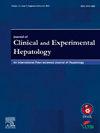Mortality and Liver-related Outcomes in Patients with Decompensated Liver Disease and Hepatogenous Diabetes
IF 3.2
Q2 GASTROENTEROLOGY & HEPATOLOGY
Journal of Clinical and Experimental Hepatology
Pub Date : 2025-05-15
DOI:10.1016/j.jceh.2025.102593
引用次数: 0
Abstract
Background
Hepatogenous diabetes (HD) is a less defined entity which refers to abnormal glucose metabolism occurring as a consequence of liver cirrhosis (LC). This prospective cohort study aimed to examine the effect of HD on the clinical outcomes in decompensated LC.
Methods
Consecutive patients with decompensated LC, with no prior diabetes mellitus and/or risk factors of metabolic syndrome, and with glycated hemoglobin (HbA1C) <6.5% and fasting blood sugar (FBS) <126 mg/dl were screened using a 2-h oral glucose tolerance test (OGTT) after 75 g glucose. They were classified as normal glucose tolerance (NGT) (FBS <100 mg/dl; OGTT 2 h <140 mg/dl) and HD (rest of the patients). Any hospital admission for ascites, hepatic encephalopathy, spontaneous bacterial peritonitis, acute kidney injury, or infection was classified as liver-related event (LRE) on follow-up. Outcomes studied were 6-month mortality, overall survival (OS), and LRE during follow-up.
Results
Of 187 patients with decompensated LC (age 44.6 ± 10.1 years; males 85%; etiology: alcohol 70%; mean MELD 17 ± 5), HD was diagnosed in 109 (58.29%) patients. NGT and HD groups were similar in age, gender; MELD score (16 ± 5 vs 18 ± 6, P = 0.06), and duration of follow-up. The HD group had higher 6-month mortality (19.27% vs 7.69%; P = 0.026) and a higher incidence of LRE at last follow-up (43.12% vs 29.49%; P = 0.058) when compared to NGT. OS (Kaplan–Meier log rank χ2 = 4.39; P = 0.03) but not LRE-free survival (Kaplan–Meier log rank χ2 = 2.0; P = 0.15), was significantly lower in HD as compared to the NGT.
Conclusion
Dysglycemia diagnosed by OGTT in decompensated cirrhosis with nondiabetic HbA1C and FBS is common. It portends poorer OS and a higher incidence of LRE.

失代偿性肝病和肝源性糖尿病患者的死亡率和肝脏相关结局
背景:肝源性糖尿病(HD)是指肝硬化(LC)导致的糖代谢异常。本前瞻性队列研究旨在探讨HD对失代偿期LC临床结局的影响。方法对连续无糖尿病和/或代谢综合征危险因素、糖化血红蛋白(HbA1C)≤6.5%、空腹血糖≤126 mg/dl的失代偿期LC患者进行75 g葡萄糖后2小时口服葡萄糖耐量试验(OGTT)筛选。他们被分为正常葡萄糖耐量(FBS <100 mg/dl;OGTT 2 h <140 mg/dl)和HD(其余患者)。任何因腹水、肝性脑病、自发性细菌性腹膜炎、急性肾损伤或感染入院的患者在随访中被归类为肝脏相关事件(LRE)。研究的结果是随访期间的6个月死亡率、总生存期(OS)和LRE。结果187例失代偿性LC患者(年龄44.6±10.1岁;男性85%;病因:酒精70%;平均MELD为17±5),109例(58.29%)患者诊断为HD。NGT组与HD组年龄、性别相近;MELD评分(16±5 vs 18±6,P = 0.06)和随访时间。HD组6个月死亡率更高(19.27% vs 7.69%;P = 0.026),末次随访时LRE发生率较高(43.12% vs 29.49%;P = 0.058)。OS (Kaplan-Meier log rank χ2 = 4.39;P = 0.03),而非LRE-free生存率(Kaplan-Meier log rank χ2 = 2.0;P = 0.15),与NGT相比,HD患者明显更低。结论OGTT诊断失代偿期肝硬化合并非糖尿病HbA1C和FBS患者血糖异常较为常见。它预示着较差的OS和较高的LRE发生率。
本文章由计算机程序翻译,如有差异,请以英文原文为准。
求助全文
约1分钟内获得全文
求助全文
来源期刊

Journal of Clinical and Experimental Hepatology
GASTROENTEROLOGY & HEPATOLOGY-
CiteScore
4.90
自引率
16.70%
发文量
537
审稿时长
64 days
 求助内容:
求助内容: 应助结果提醒方式:
应助结果提醒方式:


